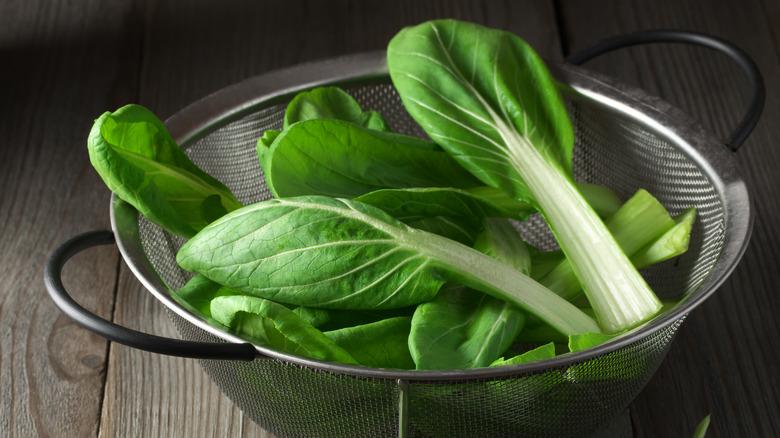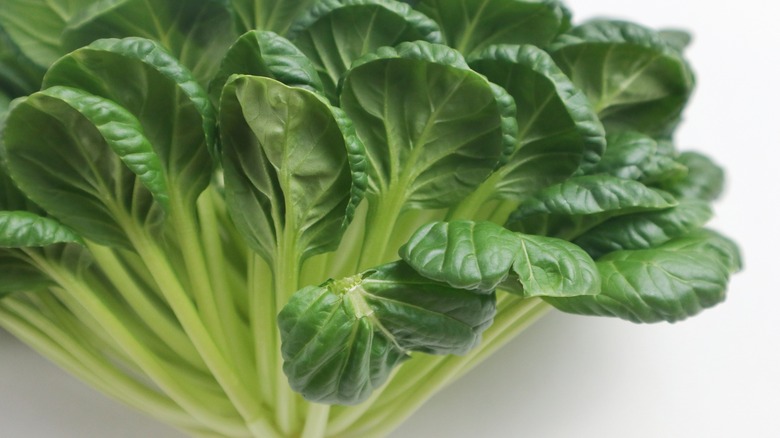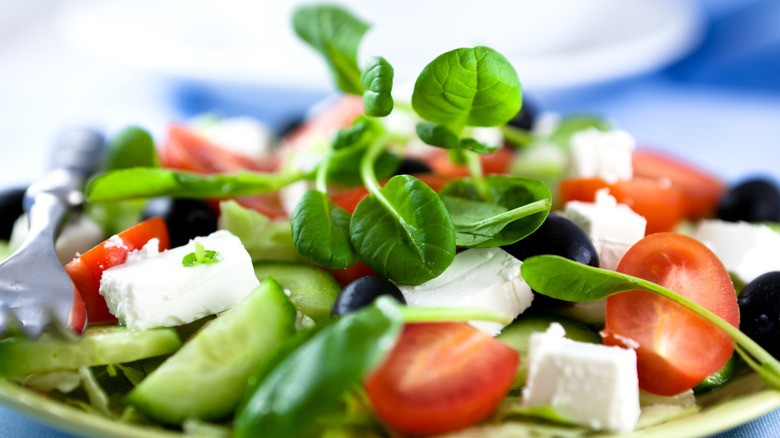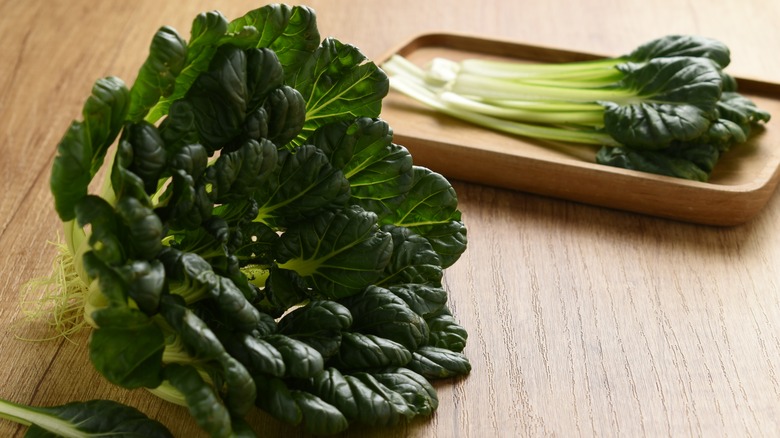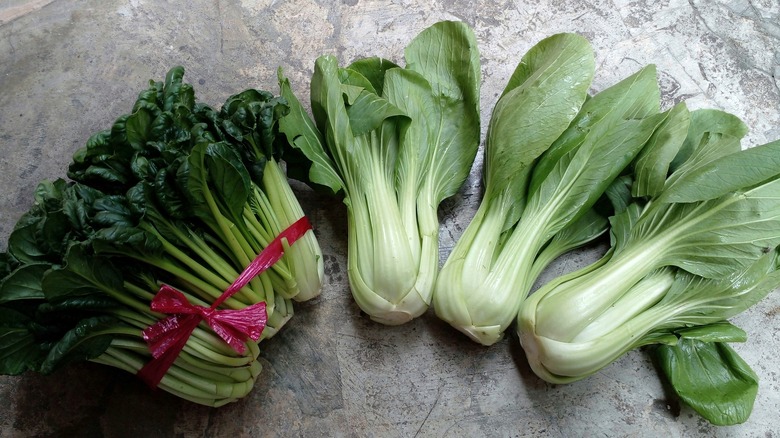Tatsoi: Brussels Sprout's Bold And Leafy Cousin
Most of us aspire to consume more leafy greens — if not solely for the reason that we read somewhere that they're good for us. But somewhere along the way kale and spinach seem to have lost their luster. There are only so many raw, dark green salads a person can eat, right? Choosing a leafy green base at the salad spot du jour gets old at a certain point.
Enter tatsoi. While not nearly as popular or commonplace as some of its family members, this gentle little leaf is a flavor and nutritional powerhouse. Think spinach, swiss chard, Brussels sprouts, and bok choy had a lovechild. All that peppery bite and bang for your buck in a gentle, dainty frond fit for any super salad.
While a cousin of Brussels sprouts and many other popular greens that line the produce aisle, what exactly is tsatsoi, what does it taste like, and how can you add more to your plate? And what makes it so bold, for that matter?
What is tatsoi?
Tatsoi is a leafy green from China, also referred to as rosette bok choy, spoon mustard (thanks to its shape), broad beak mustard, spinach mustard, and with the spelling variation as tat soy. It is a member of the Brassica rapa family, which is a subset of the Brassicaceae family of mustard and cabbage flowering plants. Turnips, broccoli rabe, Brussels sprouts, and bok choy fall into this category, as well. One thing this family has in common is their sharp, pungent, and bitter taste. That bite that makes mustard taste like, well, mustard. A cooler weather crop, the tatsoi plant matures in the spring and fall.
The leaves of tatsoi resemble a larger, leafier Brussels sprout leaf, which has a concave, curved shape. Their leaves are a slightly more vibrant shade of green while their stems are thicker and crisper white stem compared with their cousins.
The best way to enjoy tatsoi's unique flavor
Tatsoi falls on the milder end of the sharp spectrum in this family of greens. It has a taste similar to bok choy and is lightly sweet yet with a subtle, spicy bite. While all parts of the plant are edible, the stem tends to fall more toward the bitter side so culinary applications may differ. The leaves are often equated to having a similar hearty consistency and texture to spinach or Swiss chard.
Tatsoi can be enjoyed both raw and cooked. It's most commonly consumed raw in salads or for an Asian-inspired pesto. When raw, its unique flavor is best left to shine as the star of the dish you choose to feature it in.
If you prefer to cook this intertesting green, steaming it as a side dish or lightly sauteing it in a stir fry are other foolproof (and common) methods of preparing tatsoi. Much like bok choy, gentle cooking methods will enhance the flavor while still keeping the green's delightful, fresh crunch. It can also be added at the end of a simmering soup so the leaves wilt but their hue remains vibrant and nutrients intact. Speaking of nutrients ...
Tatsoi is a vitamin and mineral powerhouse
Those little leaves of tatsoi are packed with important micronutrients. According to WebMD, Tatsoi has almost twice the amount of calcium as milk. It is also high in vitamins C, A, and K. Furthermore, it is an excellent source of folate, a B vitamin that is important for metabolism as well as critical for developing fetuses. It is also chock full of potassium which helps out the heart's function.
Healthline points out that tatsoi is also a great source of fiber, as well as vitamin E and sulfur compounds, which have been linked to a myriad of healthful properties including aiding in diabetes-related issues and possibly slowing the spread of cancer.
All of this is packed into those tiny leaves, which offer up just 22 calories or units of energy in 100 grams of the raw leaves. When paired with healthy fats and protein, tatsoi is a delicious way to round out a healthy, balanced meal with a nutrient-dense punch.
Tatsoi vs. bok choy
Tatsoi and bok choy share a lot of commonalities, and for this reason, they're often packaged together in mixed greens and recipes. They look, taste, and are used pretty much interchangeably to the un-nuanced palate unfamiliar with Asian greens.
Much like bok choy, which comes in baby and adult-sized versions, the size of tatsoi also varies. You may come across the small, green leaves in a salad mix or as an intact full head. Substitution-wise, it's a straightforward swap. Just keep in mind what sized bok choy — baby bok choy versus regular — your recipe calls for, and the size of the tatsoi you picked up at the market. If you're using regular-sized tatsoi in a recipe that uses baby bok choy or vice versa, you might have to make some minor changes in cooking time and temperature. Still you'd make these same cooking adjustments if you were using a bok choy of the wrong size. Ultimately, while the leaves of tatsoi may be smaller, darker, and rounder than baby bok choy, the differences pretty much don't extend much past that.
Perhaps the biggest difference between these leafy greens is their availability. Bok choy is likely easier to come across at farmers' markets and on store shelves, you can look for tatsoi at your local Asian supermarket; it's worth getting your hands on this nutritious vegetable to try its one-of-a-kind taste when possible.
